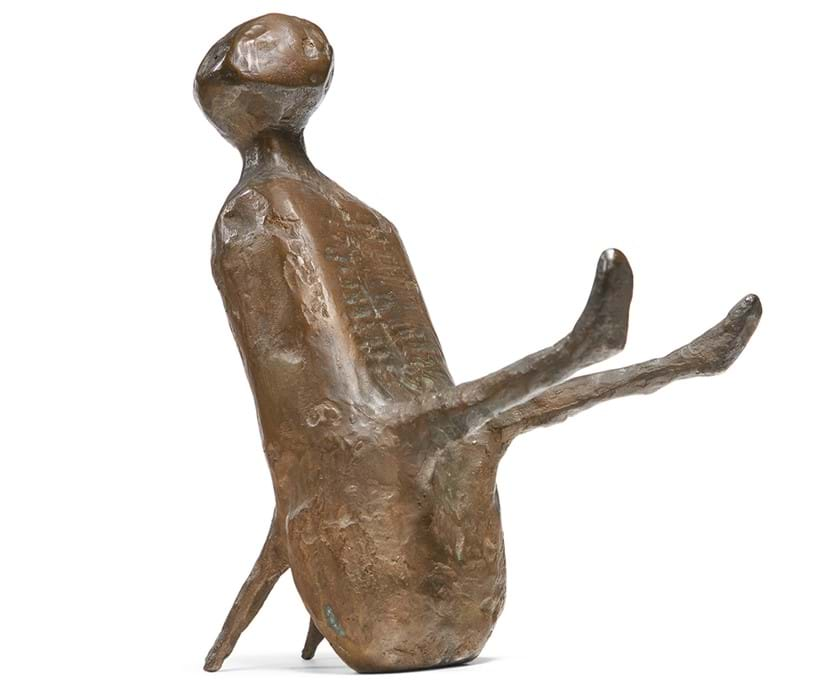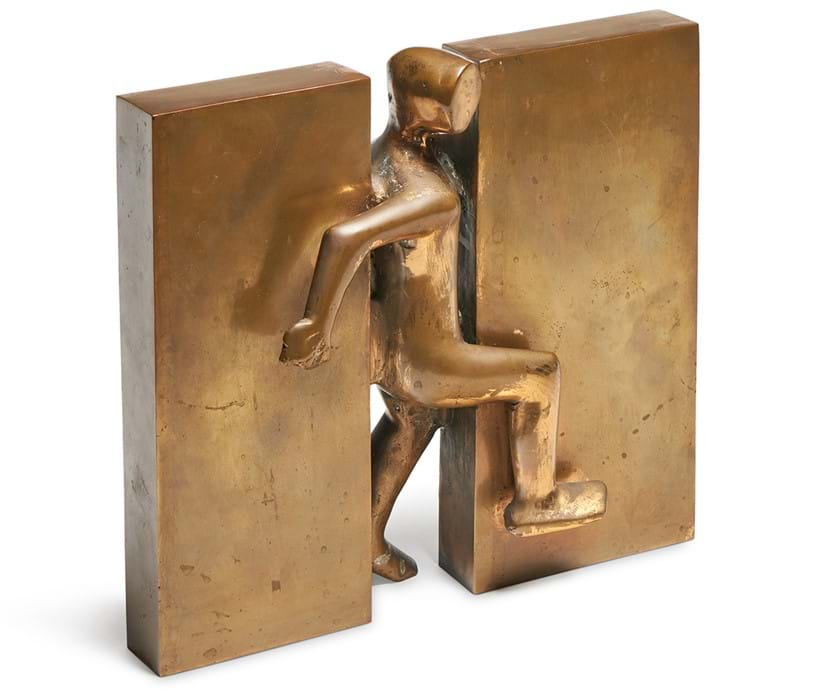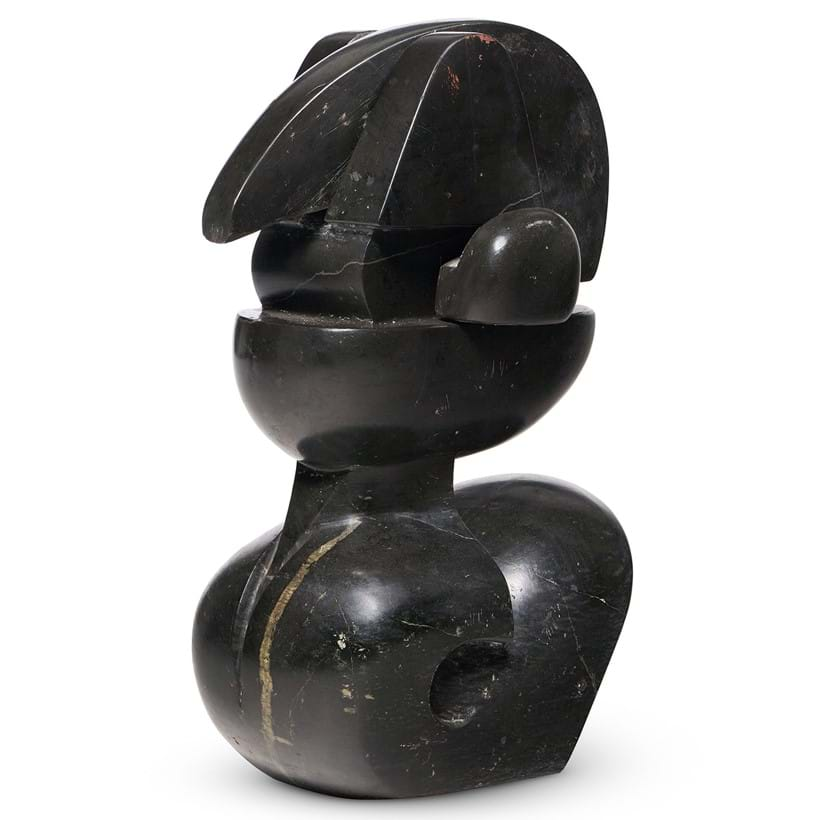The Modern Art Collection of Baroness Rawlings | 22 January 2025
The collection of Baroness Rawlings, housed at her Eaton Square flat, reflects her refined cosmopolitan taste and profound appreciation for art and history, combining furniture and decorative objects with an impressive modern art collection. On Wednesday 22 January, we are pleased to be offering her collection in our auction Town & Country: Baroness Rawlings, Eaton Square and Adlington Hall, Cheshire. Featuring works by celebrated artists such as Marc Chagall, Kenneth Armitage, Lynn Chadwick, Andrea Cascella, Marie Laurencin, and Vũ Cao Đàm, we invite you to take a closer look at the exceptional pieces that make up Baroness Rawlings's remarkable art collection.

Kenneth Armitage (British 1916-2002)
Kenneth Armitage was a leading figure in 20th century British sculpture, celebrated for his work in bronze. While working as Head of Sculpture at Bath Academy of Art, Corsham, Armitage started to explore working with new materials and techniques, moving away from carving in stone to experimenting with plaster, metal and casting in bronze. He was particularly drawn to bronze for its capability to hold both rough, unpolished textures and smooth, reflective surfaces. Baroness Rawlings's collection includes two impressive bronze sculptures by Armitage: Figure Between Walls (Lot 27), and Playful Figure (Lot 64), both acquired directly from the artist.
Conceived in 1961 in an edition of 9, Playful Figure utilises the image of man which was a central and almost exclusive concern to Armitage and his work. He saw the world of non-figuration, in which he only occasionally explored, lacking in personal and emotional resonance. Armitage believed that within the figure he could convey a sense of monumentality and stoicism, which could simultaneously be reminiscent of the heroics and sacrifice of man, made during the Second World War, in which he fought for six years, as well as presenting a sense of playfulness and joy. Although interested in the plasticity and structural form of the human figure, Armitage was not wholly concerned with naturalism, displacing the individuality of his figures in favour of psychological and formal cohesion. Playful Figure, 1961 displays an ambiguity, which was common in his work, emphasised by the lack of expression and naturalistic form. Instead there lies an emphasis on volume, weight and texture, which gained a greater significance for the artist from the 1950s onwards.

Figure Between Walls cast in the 1970s exemplifies Armitage's mature style, where the polished bronze surface conveys a sense of refinement while the figure itself, with one leg raised and arms aloft, appears deceptively straightforward. After a closer look, the missing face and the figure's positioning between two imposing blocks disrupt the apparent simplicity, introducing an ambiguity that resonates with tension and movement.
Armitage's figures often reject naturalism in favour of abstraction and psychological depth. Here, the rigid blocks juxtaposed with the figure's energetic gesture suggest both constraint and determination, evoking themes of resilience and transformation. The work balances monumentality and playfulness, reflecting Armitage's enduring ability to channel universal human emotions through sculptural form.

Lynn Chadwick (British 1914-2003)
From fellow sculptor, Lynn Chadwick, we have Lot 117, Maquette for the Trigons, also conceived in 1961. Chadwick's career gained momentum during the 1950s, securing his reputation as one of the leading sculptors in the British Modernist Sculpture movement of the mid-20th century. He first exhibited in 1950 at the Gimpel Fils gallery in London alongside Kenneth Armitage and Reg Butler. The following year, he was commissioned to create three works for the Festival of Britain, including Cypress, a mobile sculpture crafted in metal. His international acclaim was solidified in 1956 when he won the International Sculpture Prize at the Venice Biennale, followed by exhibitions in 1957 at the Saidenberg Gallery in New York.
The Maquette for the Trigons consists of three stacked angular forms supported by a three-pointed base. This distinctive base embodies the title of the work, Trigon, derived from the ancient term for triangle. Chadwick created several maquettes in the Trigon series, experimenting with varying proportions and surface finishes, all unified by the iconic three-point structure. His sculptures explore the dynamic interplay of strong, angular, and compact forms, imbued with a sense of energy. Chadwick's figures are abstracted into geometric shapes - rectangular heads, spiky legs, and bulky torsos - evoking aspects of the human body while deliberately avoiding the individualized or representational qualities typical of traditional portraiture.
The Trigon series reflects Chadwick's fascination with monolithic human forms, particularly the Moai statues of Easter Island. In 1963, a large-scale version of Trigon was acquired by Maurice Ash, Chairman of the Town and Country Planning Association, on behalf of the Harlow Art Trust and currently on display in Harlow town centre.
Andrea Cascella (Italian 1920-1990)
Born in Pescara in 1920, Andrea Cascella was a third-generation Italian sculptor. Both his Father, Tommaso, and Grandfather, Basilio, were both accomplished artists and began to teach Andrea from an early age. However, Cascella's practice mainly emerged within the wider context of the avant-garde Abstractionist movement. Cascella's work has a distinct force and structure to it that straddle a historic and modern understanding. On one hand, his use of marble echoes the art of the classical antiquity native to his heritage, whilst on the other, his use of abstract volumes that assemble themselves together to make an image is done with a modernist aesthetic. In the auction, we have Lot 49, Abstract Head by Andrea Cascella.

Marc Chagall (Russian/French 1887-1985)
The collection also includes twenty four lithographs from Marc Chagall's book The Story of Exodus printed in 1966 (Lot 98). Chagall was known for his work as a painter, lithographer, etcher and designer. The Story of Exodus is one of Chagall's most ambitious lithographic series, 24 colour works, lavishly illustrating the second book of the Bible. As with virtually all of his lithographic projects, Chagall worked with the master printer Fernand Mourlot in Paris. Atelier Mourlot was the pre-eminent lithographic studio in Paris and was where, alongside Chagall, artists such as Braque, Matisse, Miro and Picasso produced many of the most important graphic works of the 20th Century. The present work exemplifies the incredible quality of the lithographs printed at Mourlot, the perfect showcase for Chagall's mastery of the technique, his delicate, dreamlike compositions depicting the story of Exodus with a rich fluidity unlike no other.

Vũ Cao Đàm (French/Vietnamese 1908-2000)
Vũ Cao Đàm, was an important Vietnamese artist who established a unique French-Vietnamese style and explored ideas of motherhood and folklore. In the collection we have three works by the artist, Mother and child with horse leaping (Lot 142), Mother holding baby in an orange tunic (Lot 143), and Mother and child (Lot 144).
Vũ Cao Đàm was born in Hanoi under French Colonial rule and attended the École Supérieure des Beaux Arts de I'Indochine, set up by the French government in 1924. The director, Victor Tardieu, formed a syllabus to promote the study of Western traditions in art, whilst allowing space for native Vietnamese aesthetics to grow.

In 1931, Vũ Cao Đàm received a scholarship to travel to France and practice at the Cité Universitaire in Paris. During this period Vũ Cao Đàm was drawn to the impressionist and post-impressionist artists who accurately captured everyday scenes en-plein air with rapid, energetic brushstrokes, such as Van Gogh, Matisse and Renoir. Vũ Cao Đàm went on to exhibit at the Angkor Wat Pavilion during the Exposition Coloniale Internationale, as well as in the Far East Section of the École du Louvre.
In 1956, Vũ Cao Đàm relocated to the south of France where he made an important acquaintance with Marc Chagall. Chagall's swirling style and dream-like landscapes offer a clear delineation into Vũ Cao Đàm's own work, particularly Mother and Child with Horse Leaping. The mother and child are illustrated with gentle, soft features, and are sat within a clouded, formless landscape, blending outline with colour and recalling the visual lyricism of the French Impressionists. The motif of mother and child is further explored in Lots 143 and 144. The artist has focused his attention on a close-up composition directing the viewer to the mother's affectionate gaze upon her child against a backdrop of a hazy blue and green pigment.

Marie Laurencin (French 1883-1956)
Born in Paris in 1883, Laurencin became synonymous with the French avant-garde movement in the early years of the twentieth century. She initially studied porcelain painting at the famous Sevres factory before returning to the capital to attend Academie Humbert in 1904, where she met Francis Picabia and Georges Braque who introduced her to Cubism and to Picasso and members of his circle. She became part of a group known as the Section D'or, a collective of writers, artists, critics and sculptors associated with Cubism and Orphism. She exhibited at the famous Salon des Independents in 1910-1911 together with fellow artists Albert Gleizes, Robert Delaunay, Francis Picabia and Jean Metzinger. Alongside these titans of modernism, her status as a female artist meant that she is often overlooked as a footnote in the history of that period.

We are pleased to present four watercolour works by Marie Laurencin from Baroness Rawlings' collection. These works exemplify her style which was completely unique and without parallel. Laurencin uses the soft pastel tones so typical of her muted palette of pinks, blues, greens and greys. The subject matter is also amongst those frequently recurring themes of her work - elegant portraits of diaphanous women and dancers with ink outlines and flowing brushstrokes. Intimate and enigmatic, her work evades categorisation. Only rarely do we see the male form in Laurencin's work, which hints at the complex nature of her personal life. Laurencin had relationships with both men and women and although she never explicitly discussed her sexuality, modern commentators have placed her amongst what would now be termed the LGBTQ community of 1920s Paris.

View page turning catalogue
Auction Details
Wednesday 22 January 2025, 10.30am GMT
Donnington Priory, Newbury, Berkshire RG14 2JE
Browse the auction
Sign up to email alerts
VIEWING:
- Viewing in Newbury (full sale): Donnington Priory, RG14 2JE
- Sunday 19 January: 10am-3pm
- Monday 20 January: 10am-4pm
- Tuesday 21 January: 10am-4pm
- Wednesday 22 January: 9am-1pm
- Dreweatts Remote Viewing Service | Available from Sunday 19 January


















